Really, though, our trip to Rome wasn’t much of a “holiday;” it was very much about learning an ancient world with our bodies. The seven of us came to Rome with different backgrounds on classical studies and with different expectations. I had been prepared for some serious walking, and I wasn’t disappointed. I had, however, been disappointed to discover that there was no clothes washer and that my body would not acclimate to Rome’s allergy season. I quickly learned how to clean clothing by hand in a sink and how to use a clothes line- I’m actually very proud of this. After our first big group dinner, I had to clean a huge balsamic vinegar stain out of a white tank… I showed it to my mother once I was back in the States- she was extremely impressed since the stain was pretty much gone. Julia Stiles ain’t got nothin’ on me! My allergies were very much a hit and miss; some days were worse than others. I’m eternally grateful to my roommates (Kimi, McKenna, and Lana) for not smothering me in my sleep since I was making some really strange and obnoxious sounds while unconscious. I found out that despite what my body wanted to do, I could still power through. It’s quite inspiring, now that I think about it. Maybe I’ll inspire myself to continue on the path of perseverance in all things, such as working out and eating healthily.
My allergies did clear up somewhat for our day trip to Ostia, which I was extremely ecstatic about since that was the exploration I had been most excited over. Even more wonderful is that Ostia didn’t disappoint. There was a bathroom with literal bathroom humor decorated on the walls as well as a very intriguing house of Eros (is that the right name?). The sculpture that was in the ruins was lovely. I also quite liked the public restroom that was located right off the forum, in fact, that’s what I ended up sketching!
At the end of the day, we went to the Mediterranean. It was so beautiful; the sea and the sky just felt like they wanted to consume every fiber of me until I was apart of the infinite beauty of it all.
All of the churches and burial grounds (we did go to two necropolises)! I’m a bit of a fanatic when it comes to those, oddly enough. I was fascinated with how a lot of churches were built on top of ancient structures, mainly temples, or incorporated them into what they currently are. The Pantheon, originally a temple dedicated to all of the Roman gods (hence its name), became a Catholic church after being exercised of demonic spirits, or so I was told… I asked a lot of questions on the trip, and Jennifer (and maybe even Dr. Pasco-Pranger) would tell me the wrong things, admiring my gullibility. Jessica, if you ever need help hiding the body, just let me know! 😉
What I fell in love with while in Rome that made all of the aches totally worth it (besides the plumbing- such a fascinating topic!) was the Painted Garden. It had been in the triclinium (dining room) of the Villa of Livia Drusilla (fresco, 30-20 BCE) and moved to the Museo Nazionale Romano in Rome. The museum had it set up so that the lighting in the room would run through a cycle of the different natural light of the day… I tried to take pictures and videotape the effect, but technology cannot capture its beauty. If Dr. Pasco-Pranger would have allowed it, I would have stayed there all day. Who knows- I might even have tried to move in!
Another thing I really enjoyed was all of the Mithraea we came across. Something about the Mithras statues and their surroundings caught my attention…
I came to Rome to learn about the spatial aspect of the ancient city, and I got just that. It’s mind-boggling to walk on stones that have been walked on for thousands of years (kind of…) and to see and touch ancient buildings that people like Caesar and Augustus had seen and touched. Walking the city is one of my greatest accomplishments- it’s not easy, but it is so very rewarding if you are even just the tiniest bit curious about a world that has inspired our own.
Chriss’s Recommended Packing List:
-Good walking shoes (I chose Keen sandals! They were AMAZING!)
-Sunblock
-Water bottle
-Chapstick (super moisturizing)
-Reusable shopping bag (they charge you for plastic bags at grocery stores!)
-Eye drops
-Two different kinds of allergy medicine if prone to seasonal allergies
-A bag big enough to carry a water bottle, sunblock, and whatever items you need daily (I did a Kavu backpack.)
Site Report Time!
Here are my notes that I forgot when it was my day to present. My subject matter was the Stadium of Domitian. I happened to mention the archways and well… There are a lot of pictures of me in archways now. 😉 This entire report is a hodge-podge of information compiled from Rome Alive, Oxford Archaeological Guide, as well as other sources recommended by Dr. Pasco-Pranger. Some of the information was completely taken from the source, while others were combined with common information from multiple sources.
The Stadium of Domitian
1. History:
- Dedicated in 86 A.D.
- The Stadium of Domitian, also known as the Circus Agonalis, was a mass-entertainment sports venue (mainly for Greek athletic competitions, esp. foot races) located to the north of the Campus Martius. Throughout its Imperial Roman history, the Stadium was used exclusively for the presentation of the extreme physical brutality of the “agones,” Latin for “games.”
- Its arcades (fornices, “archways”) were notorious hangouts for prostitutes of both sexes, a reputation which has colored the story of St. Agnes, whose martyrdom in the Stadium in A.D. 304 (?), were occupied by brothels as were those of the Circus Maximus.
- According to the legend, St. Agnes (13 year old virgin) met a martyr’s death in the brothels in the arcades of this stadium, and in her honor a church was built in the ninth century in the middle of the cavea on the west side, which was afterwards known as S. Agnese in Agone or de Cryptis Agonis, the word agon being used both for a gymnastic contest and for the place of its celebration. Rome Alive, page 233-4 for the story.
- When the Colosseum was closed for repairs in the long period A.D. 217-228 (was struck by lightning, resulting in fire), the gladiatorial games were staged here.
- The stadium was restored by Alexander Severus and was sometimes called in the Middle Ages Circus Alexandri.
-
He placed a tax on pimps and prostitutes – the income from this went towards the cost of restoring the theater, the Circus, the Amphitheater, and the Stadium (“all structures rich in ‘archways’”) rather than into the treasury.
-
- After the administrative fall of Rome in 476 AD, and the abandonment of the city in 577 AD, the Stadium fell into initial disuse, only to be recycled during the Dark Ages as living quarters for the poor and the deliverance of outdoor sermons.
- By the dawn of the Renaissance era, the substantial portions of the structure that had survived were subsequently mined for their building materials and incorporated into burgeoning structures elsewhere.
2. Relation to surrounding structures:
- The Stadium of Domitian comprised the northernmost sentinel of what this author refers to as the “Martian Triad,” a series of impressive public buildings designed to satisfy the various tastes of the fickle Roman public. From north to south: the Stadium itself; the intimate Odeon of Domitian, used for recitals, song and orations; and the vast Theater of Pompey, reserved for what future generations would term “legitimate theater” (and legendary as the site of the murder of Julius Caesar).
3. Today:
- The Piazza Navona, the largest in the city, now called officially Circo Agonale, preserves almost exactly the shape and size of the stadium. The piazza itself corresponds closely with the arena, the length of which seems to have been about 250 meters, and the surrounding buildings stand on the ruins of the cavea. Under the church of S. Agnese remains of brick and concrete walls, travertine pilasters and the seats of the cavea are still to be seen, and other traces have been found beneath the existing buildings at other points.
- The sweep of buildings that embrace the Piazza, including the noted Church of Sant’Agnese in Agone, are largely built over – and partially incorporate – the Stadium’s original seating arrangements, which were capable of holding about 30,000 spectators
- Parts of the stadium were demolished/made visible in the late 1930s when a scheme to open a vista to the river was attempted.
- Recently, a new museum has opened up, allowing for the viewing of the stadium underground.
I will forever be indebted to the Classics Department and Dr. Pasco-Pranger for this once in a lifetime experience. I know that I’ll return to Rome some day (I did throw three coins in the Trevi Fountain after all), but I will never go at Rome in the way that this trip provided.
Arrivederci!
Chriss Fullenkamp
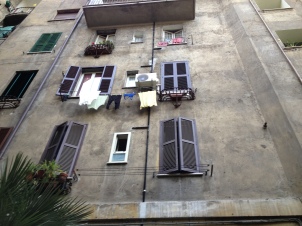
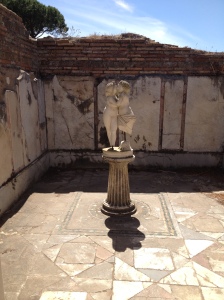
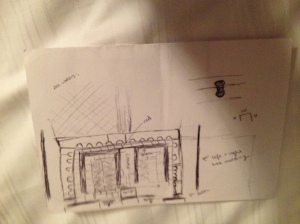
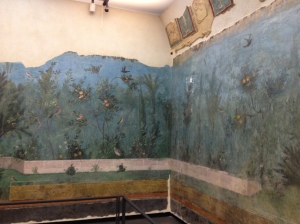

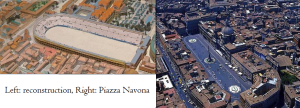
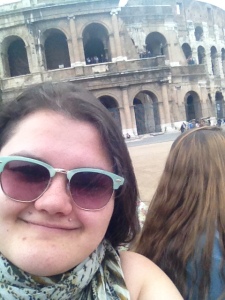
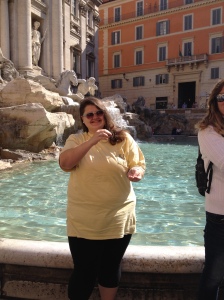
What a great and evocative post, Chriss! So glad you were with us!
Chriss!!! I thought we agreed to leave somethings in Roma!! But great report.